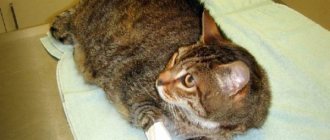Iron fist, silk glove. Sounds like the perfect description of a cat's paw. Soft, jealously protecting the depths of their hearts from sharp claws worthy of a small predator. However, cats' paws are also vulnerable and fragile.
Clots, pieces of glass, fine gravel or even a very small thorn can easily damage or injure this little ball of fur.
That's why it's important to be aware of all the bruises that can affect your cat's paws. How to recognize them? And, above all, how to react in such circumstances?
Trauma to paw pads in cats
A cat's paw pads are the parts of her body that are most susceptible to injury and bruises, which constantly threaten her. In nature or inside your apartment, any foreign object or sharp object (shards of glass, metal) that gets in its way can damage it, put a sign on it, or even make it difficult to move.
This is the reason why a thorough examination of the cat's paws is very useful in order to be able to determine the source of the disease and subsequently get rid of it.
© shutterstock
The same goes for hotplates or any other heat source that can burn and damage your little feline friend's pads.
So, if the wound on the pad is minimal and not too painful, you can treat your pet yourself. You should first try to disinfect the wound and then apply an ointment, the purpose of which is to induce healing.
However, if the wound is deep, bleeding, and extremely painful, it is wise to contact your veterinarian to properly care for your injured cat.
Consequences
If a cat falls from the third floor or lower, then in most cases there are no serious consequences. The animal is in shock for a while and then lives a normal life.
If you jump from the sixth, seventh or higher floors, the risk of serious damage increases significantly. The consequences of a cat falling from a height are immediate and secondary.
The first group includes arrest of the respiratory process and heart, serious blood loss, and shock.
Secondary consequences arise after some time. These include inflammatory processes in internal organs, impaired functioning of the kidneys and liver, infections entering the wounded surface, and blood poisoning.
With correct and timely assistance, negative consequences rarely occur.
Important! It is necessary to quickly take your pet to the hospital to reduce the risk of developing malfunctions in the functioning of organs and systems.
Bruised cat toe
A cat's toe is the part on which the claw is implanted, which is made up of tiny phalanges. Fingers are also exposed to possible accidents, which often occur during a fall, a car accident, or even when a heavy object hits them.
This is when the finger may well be broken or injured. The cat is in severe pain as soon as it places its paw on the ground, so you will observe limping, meowing with vocalizations other than a simple meow, like a kind of groan in pain. In this case, you should contact your veterinarian as soon as possible for consultation with a doctor.
Arthritis and arthrosis
This problem usually occurs in fairly old animals. In this case, lameness, of course, does not appear suddenly. At first, it becomes only slightly difficult for the pet to step on its foot. Then the problem gets worse.
If a cat has arthritis and is limping on its front leg, what should you do in this case? If there is such a problem, your pet will need to be shown to a specialist. Unfortunately, it is almost impossible to cure arthritis or arthrosis in old animals. The doctor will most likely prescribe only maintenance therapy.
Damage to a claw on a paw
Even though cat's claws are naturally tough and resistant, they are not immune to possible troubles. However, some incidents are not so serious, especially since the claws can grow back quickly.
The claw can be injured during a fight, especially during the period of estrus in females, or, for example, during a traffic accident. At this time, you should make sure that the cat has not lost one or more claws. In this case, bleeding is observed because this area is heavily vascularized.
Therefore, it is important to take your cat to a veterinarian for possible disinfection of the wound to avoid any risk of infection, and to administer adequate treatment to alleviate the animal's condition and speed up healing.
However, if the claw is indeed still implanted in its place, but is broken at the level of the keratinized and unvascularized white part, it is sufficient to simply cut it off with a claw knife designed specifically for cats. It is not recommended to use wire cutters. If the lesion is painful, it is best to contact your veterinarian.
Pretense
Sometimes it happens that the animal has no visible injuries, but the cat still limps on its front leg. The reason in this case may simply be the nature of the animal. A pet whose paw is slightly pinched or, for example, stepped on, may be offended. In this case, the cat, even if it does not feel any discomfort in its paw, begins to limping demonstratively only in order to express its indignation to its owners.
If the lameness is simply emotional, there will most likely be no damage to the animal's paw. Moreover, after a couple of hours the cat will get tired of playing, and he will stop limping.
Sprained cat paw
Whether it's an indoor cat that rarely goes outside or a cat that lives a more or less free lifestyle, all it takes is an unexpected fall and the cat will suffer pain due to a sprained one of its legs.
Victim of lameness, unable to lower its paw, sensitive to the slightest touch, active as usual, the cat spends most of the day sleeping. In this case, the cat should be quickly taken to the veterinarian for a specialized medical consultation, where he will examine it and take an x-ray to confirm that it is indeed a sprain and not a closed fracture.
Once diagnosed, the veterinarian will need to immediately administer anti-inflammatory medications for pain relief and prescribe eyedroppers for the next 6 days. While awaiting rehabilitation, the cat should avoid any physical exertion that could jeopardize its recovery.
Treatment
Therapeutic measures carried out in a clinical setting depend on the identified cause of lameness.
- Dislocation.
The animal is given local anesthesia and the dislocated joint is adjusted, then a fixing bandage is applied. - Fracture.
The cat is given local or general anesthesia if the fracture is open, bone fragments are removed from the wound, and damaged tissue is excised. After this, a plaster cast is applied to the paw. - Hip dysplasia.
The basis of drug therapy is a course of chondroprotectors (Artroglycan, Cosequin, ArthroVet, Joint Max, Stride Plus, Chondartron). If necessary, the cat may be prescribed intra-articular injections of absorbable drugs and/or hyaluronic acid. In severe cases, surgical removal of the femoral head that has lost functionality is used.
- Arthritis, arthrosis, osteomyelitis, osteochondrosis.
Diseases accompanied by degenerative changes in bone tissue require a complex of therapeutic measures. Anti-inflammatory, painkillers, chondroprotectors, vitamins, and mineral supplements are used. Massage and ultraviolet irradiation give good results. - Infectious diseases
. For lameness caused by chlamydia, calcivirosis, mycoplasmosis, therapy is aimed at destroying pathogenic microflora, relieving pain and strengthening the immune system. Tetracycline antibiotics, analgesics, immunomodulators and immunostimulants are used.
In some cases, the cause of lameness cannot be determined. Then the veterinarian will most likely prescribe anti-inflammatory treatment, select a diet high in vitamins, minerals and substances that help strengthen bone and cartilage tissue, and also recommend limiting the cat’s physical activity for a while: keeping it indoors, not allowing it to jump with great height. It is quite possible that such methods will give the desired result, and the lameness will go away.
Cat paw fracture
A broken paw is the result of a serious traumatic shock that occurs during a fight between cats, a traffic accident, or an unsuccessful jump or fall. In rare cases, growth failure can also result in a broken leg in a young kitten.
However, sometimes such a wound may go unnoticed in a cat with a more or less tenacious and independent temperament. But in general, a cat with a broken paw suffers from severe pain.
Clinical signs may be:
- The animal limps and has difficulty moving.
- It is difficult for a cat to place its paw on the ground.
- The cat meows and groans in pain.
- Bone rubbing may be heard.
If the fracture is closed, meaning it is not exposed to the outside environment, it can be bandaged and splinted while awaiting appropriate veterinary care.
On the other hand, in the case of an open fracture exposing the injured bone, the application of a bandage is not recommended, the animal must be taken without wasting time to the veterinarian, where it will be subjected to various additional examinations to assess the extent and severity of the wound and be able to provide it with the necessary care, adapted to her case.
© shutterstock
As in humans, fractures can cause collateral damage that must be considered and treated along with the primary injury.
Often an injury or fracture that occurs during an accident is accompanied by bleeding, damage to the animal's spleen and liver or spine. General care is generally considered to help avoid any risk of complications.
Lesions or open wounds must be thoroughly cleaned, disinfected, and then follow-up sessions.
First aid for falling from a height
What to do if a cat fell from the 3rd floor? Carefully examine the animal and go to the doctor. In most cases, this height does not pose any particular danger to cats.
The cat fell from the 5th floor: consequences, what to do
If a cat fell from the 6th floor, then you need to immediately take the necessary measures and provide first aid to the injured animal. It includes several actions that should be carried out in the first couple of hours after the fall:
- First of all, you need to find the cat and examine it without touching it.
- If the animal cannot move, then you need to try to put something flat under it - a sheet of thick cardboard, plywood, the bottom of a carrier, the head needs to be fixed.
- The pet is immediately taken to a veterinary clinic or taken home, but they try to ensure peace.
- If the cat is unconscious, resuscitation is carried out - the mouth is opened, the tongue is pulled out, the nose is closed with the fingers. Then artificial respiration must be performed through gauze - air is blown into the animal’s mouth. It is important to monitor the movement of the diaphragm.
- Bandages soaked in solutions of furatsilin or chlorhexidine are applied to areas of open damage. If necessary, replace with fresh ones.
- If internal bleeding is suspected, cold compresses may be applied to the cat's abdomen and head.
Important! Arbitrary use of medications and self-treatment is not allowed. Such measures often lead to negative consequences.
After a fall, you should not move the cat intensively, try to feed or drink it, try to straighten dislocations or apply a splint, or tilt its head back.
If a kitten falls from a height, the owners do not always know what to do and are often lost. When your baby falls out, you need to see a doctor very quickly. Kittens have a less developed immune system and body as a whole; a small loss of blood will negatively affect their condition.
How to identify a paw bruise
Bruised cat paws can have a variety of causes. As explained earlier, small glass crystals, pebbles, metal fragments, thorns, falls, or even burns can cause injuries to a cat's paw.
Any sharp foreign body can cause lameness, inability to place the affected paw on the ground, injury to the pad or tear of the nail, and particularly severe pain or lameness.
The wound can range from a simple superficial scratch to a deep open fracture. As soon as you notice that your cat can't move, take the time to check and inspect those paws, especially the one that he can't put on the ground. If you can't find a trace of blood and it's not too painful, you can disinfect it yourself and keep your pet in a quiet place and monitor him for a few days.
If after a few days the cat’s condition does not improve and its condition worsens: fever, weight loss, refusal to eat, you must take your pet to the veterinarian. This is the only way to determine the cause and develop an effective therapeutic strategy.
If the wound is open, extensive, penetrating and hemorrhagic, accompanied by severe pain expressed by groans, it is necessary to take the sick cat to the veterinarian so that he can examine the wound and begin treatment.
The veterinarian will perform a thorough clinical examination, usually requiring x-rays. In some cases, surgery is considered and hospitalization for several days is required.
Diagnostics
The success of lameness treatment directly depends on the correct diagnosis and timely use of therapy. During an orthopedic examination of a cat, the veterinarian observes how it walks, stands, sits, and how mobile the joints of its limbs are. It will be determined whether there are painful areas on the paws, swelling, joint abnormalities or areas of elevated temperature.
In difficult cases, additional examinations may be prescribed to clarify the diagnosis:
- Blood and urine tests. They are necessary if infectious or autoimmune diseases are suspected, as well as if the cat is undergoing surgery under anesthesia;
- Biopsy;
- Analysis of the synovial fluid filling the joint cavity;
- X-ray of joints or spinal canal (myelography);
- Ultrasound examination of joints and/or spine;
- Magnetic resonance imaging.
In what cases should a cat be taken to the veterinarian?
When is specialist help needed? When the animal exhibits at least one of the following symptoms:
- the cat cannot walk at all or moves with great difficulty;
- when you touch the paw, the pet meows and abruptly pulls it away;
- the cat does not step on its paw, tucking it in when moving.
It is also worth visiting a specialist if the cat’s lameness is accompanied by loss of appetite, high fever, increased fatigue, lethargy or aggression. These are already very alarming symptoms.











